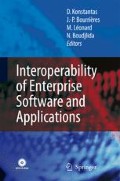Summary
A number of technologies are mentioned under the rubric of “The Semantic Web”, but good overviews of these technologies with an eye toward practical applications are scarce. Moreover, much of the early focus in this field has been on the development of representation languages for static conceptual information, while there has been less emphasis on how to make semantic web applications practically useful in the context of knowledge work. To achieve this, a better coupling is needed between ontology, service descriptions and workflow modeling. This paper reviews all the basic technologies involved in this, and outlines what can be achieved by merging them in the context of real world workflow descriptions.
Access this chapter
Tax calculation will be finalised at checkout
Purchases are for personal use only
Preview
Unable to display preview. Download preview PDF.
References
Berners-Lee, T., Hendler, J., and Lassila, O. The Semantic Web., Scientific American, 2001, May
Daconta, M.C., Orbst, L.J., Smith, K.T The Semantic Web, Wiley, 2003
Grigoris, A. & v. Harmelen, F. Web Ontology Language: OWL, in Handbook On Ontologies, Eds. International Handbooks on Information Systems, Springer, 2004, Berlin, Germany
McGuiness, D. L. Ontologies Come of Age, in Spinning the Semantic Web, Fensel, D., Hendler, J., Lieberman, H. Wahlster, W, Eds., MIT Press, 2003, Cambridge, MA.
Staab, S. & Studer R., Handbook On Ontologies, International Handbooks on Information Systems, Springer, Berlin, Germany, 2004
OWL Web Ontology LanguageUse Cases and Requirements, 2004, http://www.w3.org/TR/webont-req/, Accessed Aug. 23, 2004
Jøgensen, H. D., 2004, Interactive Process Models, PhD-thesis, NTNU, Trondheim, Norway, ISBN 82-471-6203-2
Bandinelli, S., Fuggetta, A., Lavazza, L., Loi, M., and Picco, G.P. Modeling and Improving an Industrial Software Process, IEEE Transactions on Software Engineering, vol. 21, no. 5, 1995.
Derniame, J. C. Software Process: Principles, Methodology and Technology, LNCS 1500, Springer, Berlin, Germany, 1998
Brathaug, T. A., and Evjen, T. A. Enterprise Modeling, STF 38 A96302, 1996, Trondheim, Norway
Fox, M. S. and Gruninger, M. Enterprise Modeling, AI Magazine, 2000
Ambriola, V., Conradi, R., and Fuggetta, A. Assessing Process-Centered Software Engineering Environments, ACM Transactions on Software Engineering and Metho, 6,3, 1997
WfMC Workflow Handbook 2001, Workflow Management Coalition, Lighthouse Point, Florida, USA, 2000
Carlsen, S Conceptual Modeling and Composition of Flexible Workflow Models, Norwegian University of Science and Technology, 1997
Conradi, R. and Jaccheri, M. L. Process Modelling Languages, in Software Process: Principles, Methodology and Tech, Eds. Lecture Notes in Computer Science, Springer LNCS 1500, 1998
Curtis, B., Kellner, M. I., and Over, J. Process Modeling, Communications of the ACM, 35,9, 1992
Green, P. and Rosemann, M. Integrated Process Modeling: An Ontological Evaluation, Information Systems, 25,3, 2000
Lei, Y. and Singh, M. P. A. A Comparison of Workflow Metamodels, in ER Workshop on Behaivoral Modeling, Eds., Springer LNCS 1565, 1997
Bolcer, G. and Kaiser, G. SWAP: Leveraging the Web to Manage Workflow, IEEE Internet Computing, 3,1, 1999
OMG Workflow Management Facility v. 1.2, OMG, 2000
WfMC Workflow Management Coalition, Interface 1: Process Definition Interch, Draft 5.0, Workflow Management Coalition, 1996
Arkin, A. Business Process Modeling Language-BPML 1.0 Working Draft, BPML.org, 2002
Scheer, A.W. and Nuttgens, M., ARIS Architecture and Reference Models for Business Process Management, in Business Process Management, W. v.d. Aalst, J. Desel, and A. Oberweis, Eds., Springer LNCS 1806, 2000, Berlin
Aalst, W. M. P. v. d. Formalization and Verification of Event-driven Process Chains, Information and Software Technology, 41,10, 1999.
Loos, P. and Allweyer, T. Process Orientation and Object Orientation-An Approach for Integrating UM, University of Saarland, Germany, 1998
Workflow Process Definition Interface-XML Process Definition Language, 2002, http://www.wfmc.org/standards/docs/TC-1025_10_xpdl,(Aug. 19, 2004)
Krogstie, J. Integrating Enterprise and IS-development Using a Model-Driven Approach. in 13th International Conference on Information Systems Development. 2004. Vilnius, Lithuania: Kluwer
Lillehagen, F., 1999, Visual extended enterprise engineering embedding knowledge management, systems engineering and work execution, Proceedings of IEMC’ 99, IFIP International Enterprise Modelling Conference, Verdal, Norway
Haake, J. M., and Wang, W., 1997, Flexible support for business processes: Extending cooperative hypermedia with process support, Proceedings of GROUP’ 97, Phoenix, Arizona USA
Kuntz, J. C., Christiansen, T. R., Cohen, G. P., Jin, Y., and Levitt, R. E., 1998, The virtual design team: A computational simulation model of project organizations, Communications of the ACM, vol. 41, no. 11
Krogstie, J., and Jøgensen, H. D., 2004, Interactive models for supporting networked organizations. Proceedings of CAiSE’ 2004, June 9–11, Latvia, Riga
Author information
Authors and Affiliations
Editor information
Editors and Affiliations
Rights and permissions
Copyright information
© 2006 Springer-Verlag London Limited
About this paper
Cite this paper
Krogstie, J., Veres, C., Sindre, G. (2006). Interoperability through integrating Semantic Web Technology, Web Services, and Workflow Modeling. In: Konstantas, D., Bourrières, JP., Léonard, M., Boudjlida, N. (eds) Interoperability of Enterprise Software and Applications. Springer, London. https://doi.org/10.1007/1-84628-152-0_14
Download citation
DOI: https://doi.org/10.1007/1-84628-152-0_14
Publisher Name: Springer, London
Print ISBN: 978-1-84628-151-8
Online ISBN: 978-1-84628-152-5
eBook Packages: Computer ScienceComputer Science (R0)

